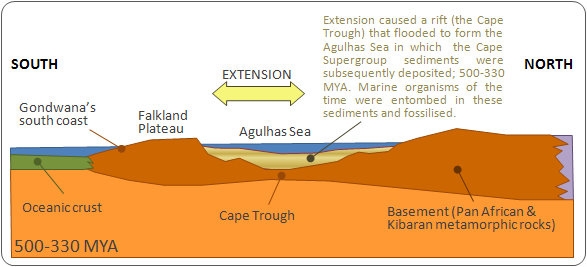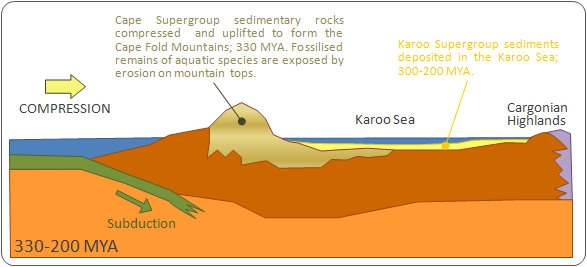The geology of the coast of South Africa from Cape Town to Port Elizabeth is dominated by sedimentary rock, but there are some good examples of igneous and metamorphic rock. An interesting example of a type of metamorphic rock can be found at Schoenmakerskop.
EDUCATIONAL LOGGING REQUIREMENTS
In order to substantiate your visit and comply with the educational requirement for Earth Caches you have to submit your answers to the following questions to the cache developers via their profile:
For purposes of logging this cache you must answer the following five questions.
TO LOG THIS CACHE AND QUALIFY you need to answer the following questions in an email to the cache owner via our profile on the geocaching website. Any logs not accompanied by an email will be deleted.
1) Identify the phyllite. How did you know it is phyllite? In your answer refer to the colour of the rock, the grain size and the direction.
2) Look at the phyllite. Try and estimate the angle that this layer is tilted at. If the horizontal is 0° and the vertical is 90° - estimate the angle.
3) What is the nature of the surface of the phyllite? Is it smooth rough? Would it be comfortable to walk over? Why is this?
4) At the listed coordinates there are two benches to sit on. Who does the Southern one belong to?
5) There is lighter coloured rock (with an orange colouring) in the area. What rock is this? Apart from the colour, what is the main difference between this rock and the phyllite. We are referring to the large rock banks not the quartz that can be found in the phyllite.
|
CAPE SUPERGROUP
The extension and rifting of the crust of what is now known as the Southern Cape created a depression, the Agulhas Sea. Sedimentation occurred in this depression forming the rock of the Cape Supergroup.  .
.
About 330 million years ago a subduction zone developed causing compression and the sedimentary rock of the Cape Supergroup began to fold forming a mountain range. The intense pressures and heat caused by the folding resulted in the sedimentary rock metamorphosing into metamorphic rock. 
The rock of the Cape Supergroup stretches from Cape Town to Port Elizabeth and dominates the geology of the South Western portion of South Africa.
METAMORPHIC ROCKS
Metamorphic rocks arise from the transformation of existing rock types, in a process called metamorphism, which means "change in form". The original rock is subjected to heat and pressure, causing profound physical and/or chemical change. Metamorphic rocks make up a large part of the Earth's crust and are classified by texture and by chemical and mineral assemblage.
There are two types of metamorphysim, namely Contact metamorphism and Regional metamorphism.
Contact metamorphism is the name given to the changes that take place when magma is injected into the surrounding solid rock. The changes that occur are greatest wherever the magma comes into contact with the rock because the temperatures are highest at this boundary and decrease with distance from it.
Regional metamorphism, also known as dynamic metamorphism, is the name given to changes in great masses of rock over a wide area. Rocks can be metamorphosed simply by being at great depths below the Earth's surface, subjected to high temperatures and the great pressure caused by the immense weight of the rock layers above.
Examples of metamorphic rock are marble which is formed from limestone and chalk, quartzite which is metamorphic sandstone and slate which is a metamorphic mudstone or shale.
Slate is a fine-grained, foliated, homogeneous metamorphic rock derived from an original shale-type sedimentary rock composed of clay or volcanic ash through low-grade regional metamorphism. It is the finest grained foliated metamorphic rock. If slate is metamorphosed further it becomes phyllite which is a low grade metamorphic rock comprising mostly flattened, flaky minerals like mica, chlorite and talc. It has a good fissility (a tendency to split into sheets). Phyllites are usually black to grey or light greenish grey in color. Phyllite is normally formed by directional stress during folding. If phyllyte is subject to a greater degree of heat and pressure it becomes schist.
Phyllite can be identified by its colour and its finely wavy face. Whereas slate usually breaks in very flat sheets, phyllite tends to have a corrugated cleavage. Phyllite also has larger crystals than slate. This gives it a greater degree of light reflection or sheen. Slate is usually dull and non reflective.The sheen is used to distinguish phyllite from slate.
A good example of phyllite can be seen at Schoenmakerskop. The listed coordinates will take you to a spot where phyllite is clearly visible.
Close observation will also reveal some white to grey/black quartz infused into the phyllite
The entire sequence at Schoenmakerskop was deformed some 300 million years ago, at a depth of a few kilometres below the present surface.
References
McCarthy T & Rubidge B (2005). The story of Earth & Life: A Southern African perspective on a 4.6-billion-year journey.
Wikipedia
Nick Norman & Gavin Whitfield (2006) Geological Journeys
Geocache GC336KY set by Hesamati.